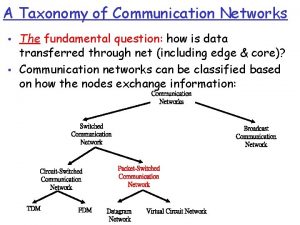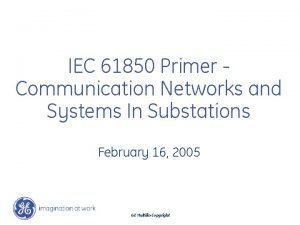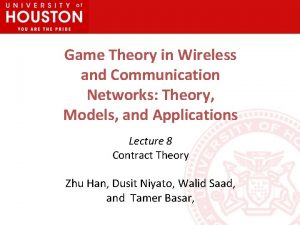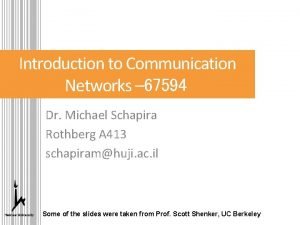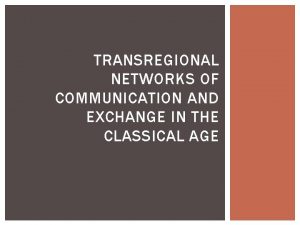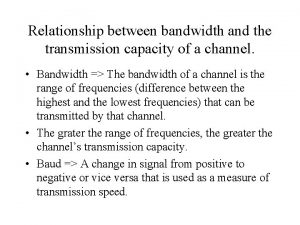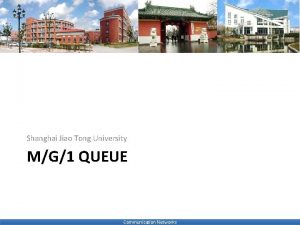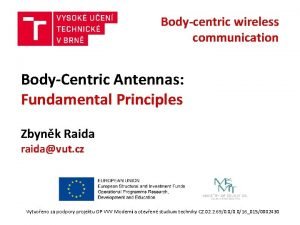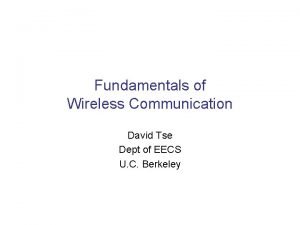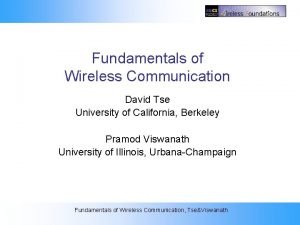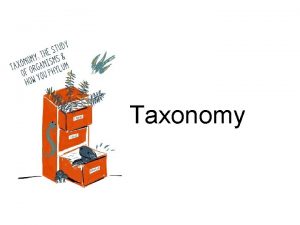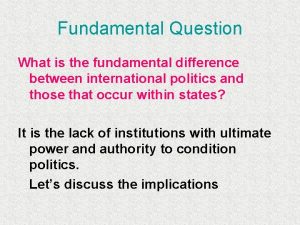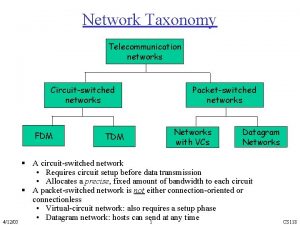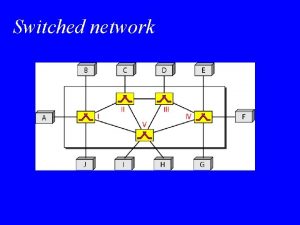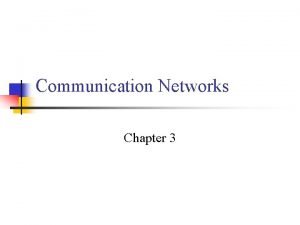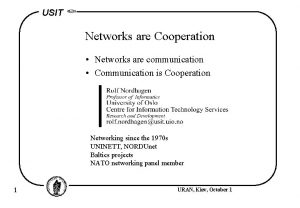A Taxonomy of Communication Networks The fundamental question


















- Slides: 18

A Taxonomy of Communication Networks • The fundamental question: how is data transferred through net (including edge & core)? • Communication networks can be classified based on how the nodes exchange information: Communication Networks Switched Communication Network Circuit-Switched Communication Network TDM FDM Broadcast Communication Network Packet-Switched Communication Network Datagram Network Virtual Circuit Network

Packet Switching • • Data is sent as formatted bit-sequences (Packets) Packets have the following structure: Header o • • • Data Trailer Header and Trailer carry control information (e. g. , destination address, check sum) Each packet traverses the network from node to node along some path (Routing) At each node the entire packet is received, stored briefly, and then forwarded to the next node (Store-and-Forward Networks) No dedicated allocation or resource reservation – no guarantees!

Packet Switching: Statistical Multiplexing 10 Mbs Ethernet A B statistical multiplexing C 1. 5 Mbs queue of packets waiting for output link D E Sequence of A & B packets does not have fixed pattern �statistical multiplexing. In TDM each host gets same slot in revolving TDM frame.

Packet Switching versus Circuit Switching Packet switching allows more users to use network! • 1 Mbit link • Each user: o 100 kbps when “active” o active 10% of time • Circuit-switching: o 10 users N users • Packet switching: o with 35 users, probability > 10 active less than. 0004 1 Mbps link

Packet Switching versus Circuit Switching • Great for bursty data resource sharing o simpler, no call setup • Excessive congestion: packet delay and loss o protocols needed for reliable data transfer, congestion control • Q: How to provide circuit-like behavior? o bandwidth guarantees needed for audio/video apps o still an unsolved problem o

A Taxonomy of Communication Networks • The fundamental question: how is data transferred through net (including edge & core)? • Communication networks can be classified based on how the nodes exchange information: Communication Networks Switched Communication Network Circuit-Switched Communication Network TDM FDM Broadcast Communication Network Packet-Switched Communication Network Datagram Network Virtual Circuit Network

Datagram Packet Switching • Each packet is independently switched o Each packet header contains destination address which determines next hop o Routes may change during session o E. g. , post-office analogy • No resources are pre-allocated (reserved) in advance • Example: IP networks

Timing of Datagram Packet Switching Host 1 transmission time of Packet 1 at Host 1 Node 1 Packet 2 Packet 3 Host 2 Node 2 propagation delay between Host 1 and Node 1 Packet 1 processing delay of Packet 1 at Node 2 Packet 3 Packet 1 Packet 2 Packet 3

Datagram Packet Switching Host C Host D Host A Node 1 Node 2 Node 3 Node 5 Host B Node 6 Node 4 Node 7 Host E

A Taxonomy of Communication Networks • The fundamental question: how is data transferred through net (including edge & core)? • Communication networks can be classified based on how the nodes exchange information: Communication Networks Switched Communication Network Circuit-Switched Communication Network TDM FDM Broadcast Communication Network Packet-Switched Communication Network Datagram Network Virtual Circuit Network

Virtual-Circuit Packet Switching • Hybrid of circuit switching and packet switching o All packets from one packet stream are sent along a pre-established path (= virtual circuit) o Each packet carries tag (virtual circuit ID), tag determines next hop • Features o Guarantees in-sequence delivery of packets (+) o However, packets from different virtual circuits may be interleaved (+) o Requires per-flow state in the network (-)

Virtual-Circuit Packet Switching • Communication with virtual circuits takes place in three phases 1. 2. 3. VC establishment data transfer VC disconnect • Note: packet headers don’t need to contain the full destination address of the packet

Timing of Virtual-Circuit Packet Switching Host 1 Node 1 Host 2 Node 2 propagation delay between Host 1 and Node 1 VC establishment Packet 1 Packet 2 Data transfer Packet 3 Packet 1 Packet 2 Packet 3 VC termination

Virtual-Circuit Packet Switching Host C Host D Host A Node 1 Node 2 Node 3 Node 5 Host B Node 6 Node 4 Node 7 Host E

Overview • Network access and physical media • Internet structure and ISPs • Delay & loss in packet-switched networks • Protocol layers, service models

Access networks and physical media Q: How to connect end systems to edge router? v residential access nets v institutional access networks (school, company) v mobile access networks Keep in mind: v v bandwidth (bits per second) of access network? shared or dedicated?

Dial-up Modem central office home PC v v v home dial-up modem telephone network Internet ISP modem (e. g. , AOL) uses existing telephony infrastructure § home directly-connected to central office up to 56 Kbps direct access to router (often less) can’t surf, phone at same time: not “always on”

Digital Subscriber Line (DSL) Existing phone line: 0 -4 KHz phone; 4 -50 KHz upstream data; 50 KHz 1 MHz downstream data home phone Internet DSLAM telephone network splitter DSL modem home PC v v central office uses existing telephone infrastructure up to 1 Mbps upstream (today typically < 256 kbps) up to 8 Mbps downstream (today typically < 1 Mbps) dedicated physical line to telephone central office
 Question
Question Kendall and marzano's new taxonomy
Kendall and marzano's new taxonomy Taxonomy communication
Taxonomy communication Datagram switching
Datagram switching Backbone networks in computer networks
Backbone networks in computer networks Iec 61850 communication networks and systems in substations
Iec 61850 communication networks and systems in substations Game theory in wireless and communication networks
Game theory in wireless and communication networks Introduction to communication networks
Introduction to communication networks Networks of communication and exchange
Networks of communication and exchange A communication processor that connects dissimilar networks
A communication processor that connects dissimilar networks Industrial communication networks
Industrial communication networks Pollaczek khinchin formula
Pollaczek khinchin formula Fundamental principles of wireless communication
Fundamental principles of wireless communication Fundamentals of wireless communication solution
Fundamentals of wireless communication solution Fundamental of wireless communication
Fundamental of wireless communication Questions without question words
Questions without question words Closed question example
Closed question example Contoh open-ended question adalah
Contoh open-ended question adalah Non researchable question
Non researchable question


